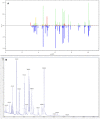Elizabethkingia miricola Causes Intracranial Infection: A Case Study
- PMID: 35004734
- PMCID: PMC8739271
- DOI: 10.3389/fmed.2021.761924
Elizabethkingia miricola Causes Intracranial Infection: A Case Study
Abstract
Background: Elizabethkingia miricola is a rarely encountered bacterium in clinical practice. It is a rare gram-negative rod-shaped bacterium associated with lung and urinary tract infections, but never found in cerebrospinal fluid. This paper reports a case of an adult patient infected by E. miricola via an unknown route of infection causing a severe intracranial infection. Elizabethkingia miricola was detected by culture and Metagenomic next generation sequencing in CSF. Early identification of this strain and treatment with sensitive antibiotics is necessary to reduce morbidity and mortality. Case Report: A 24-year-old male was admitted to a West China Hospital because of headache and vomiting for 2 months. Symptom features included acute onset and long duration of illness. Notably, headache and vomiting were the primary neurological symptoms. Routine cerebrospinal fluid culture failed to identify the bacterium; however, Elizabethkingia miricola bacterium was detected via second-generation sequencing techniques. Elizabethkingia miricola was found to be a multi-drug resistant organism, hence, treatment with ceftriaxone, a commonly used drug for intracranial infections was ineffective. This strain eventually caused severe intracranial infection resulting in the death of the patient. Conclusion: In summary, this study comprehensively describes a case of an adult patient infected by E. miricola and discusses its early identification as well as application of sensitive antibiotics in the emergency setting.
Keywords: Elizabethkingia miricola; bacterial infection; case report; intracranial infection; neurology.
Copyright © 2021 Gao, Li, Feng and Zhang.
Conflict of interest statement
The authors declare that the research was conducted in the absence of any commercial or financial relationships that could be construed as a potential conflict of interest.
Figures



Similar articles
-
Elizabethkingia miricola: A rare non-fermenter causing urinary tract infection.World J Clin Cases. 2017 May 16;5(5):187-190. doi: 10.12998/wjcc.v5.i5.187. World J Clin Cases. 2017. PMID: 28560237 Free PMC article.
-
Acute bacterial encephalitis complicated with recurrent nasopharyngeal carcinoma associated with Elizabethkingia miricola infection: A case report.Front Neurol. 2023 Jan 27;13:965939. doi: 10.3389/fneur.2022.965939. eCollection 2022. Front Neurol. 2023. PMID: 36776576 Free PMC article.
-
Elizabethkingia miricola as an opportunistic oral pathogen associated with superinfectious complications in humoral immunodeficiency: a case report.BMC Infect Dis. 2017 Dec 12;17(1):763. doi: 10.1186/s12879-017-2886-7. BMC Infect Dis. 2017. PMID: 29233117 Free PMC article.
-
Elizabethkingia Infections in Humans: From Genomics to Clinics.Microorganisms. 2019 Aug 28;7(9):295. doi: 10.3390/microorganisms7090295. Microorganisms. 2019. PMID: 31466280 Free PMC article. Review.
-
Diagnosis of Streptococcus suis Meningoencephalitis with metagenomic next-generation sequencing of the cerebrospinal fluid: a case report with literature review.BMC Infect Dis. 2020 Nov 25;20(1):884. doi: 10.1186/s12879-020-05621-3. BMC Infect Dis. 2020. PMID: 33238913 Free PMC article. Review.
Cited by
-
Unraveling the global landscape of Elizabethkingia antibiotic resistance: A systematic review and meta-analysis.PLoS One. 2025 May 30;20(5):e0323313. doi: 10.1371/journal.pone.0323313. eCollection 2025. PLoS One. 2025. PMID: 40446068 Free PMC article.
-
Immune Activation and Inflammatory Response Mediated by the NOD/Toll-like Receptor Signaling Pathway-The Potential Mechanism of Bullfrog (Lithobates catesbeiana) Meningitis Caused by Elizabethkingia miricola.Int J Mol Sci. 2023 Sep 26;24(19):14554. doi: 10.3390/ijms241914554. Int J Mol Sci. 2023. PMID: 37833994 Free PMC article.
-
Linalool exhibit antimicrobial ability against Elizabethkingia miricola by disrupting cellular and metabolic functions.Curr Res Microb Sci. 2025 Mar 23;8:100380. doi: 10.1016/j.crmicr.2025.100380. eCollection 2025. Curr Res Microb Sci. 2025. PMID: 40225044 Free PMC article.
-
Elizabethkingia Anophelis and Miricola in El Salvador: Report of the first three cases.IDCases. 2025 May 25;40:e02272. doi: 10.1016/j.idcr.2025.e02272. eCollection 2025. IDCases. 2025. PMID: 40503518 Free PMC article.
-
Natural occurrences and characterization of Elizabethkingia miricola infection in cultured bullfrogs (Rana catesbeiana).Front Cell Infect Microbiol. 2023 Mar 14;13:1094050. doi: 10.3389/fcimb.2023.1094050. eCollection 2023. Front Cell Infect Microbiol. 2023. PMID: 36998635 Free PMC article.
References
Publication types
LinkOut - more resources
Full Text Sources

